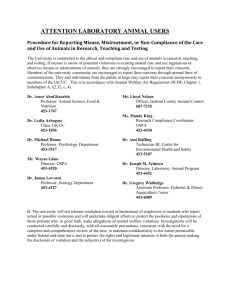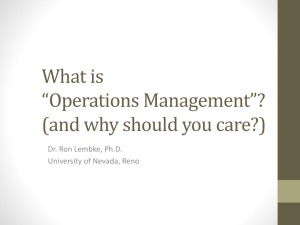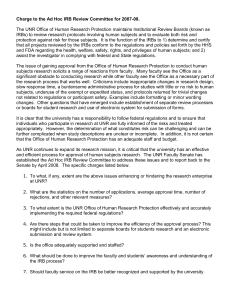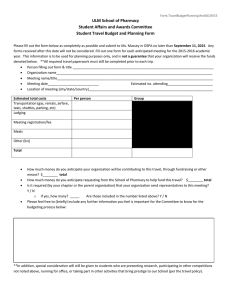2008-09 Year-end Report
advertisement
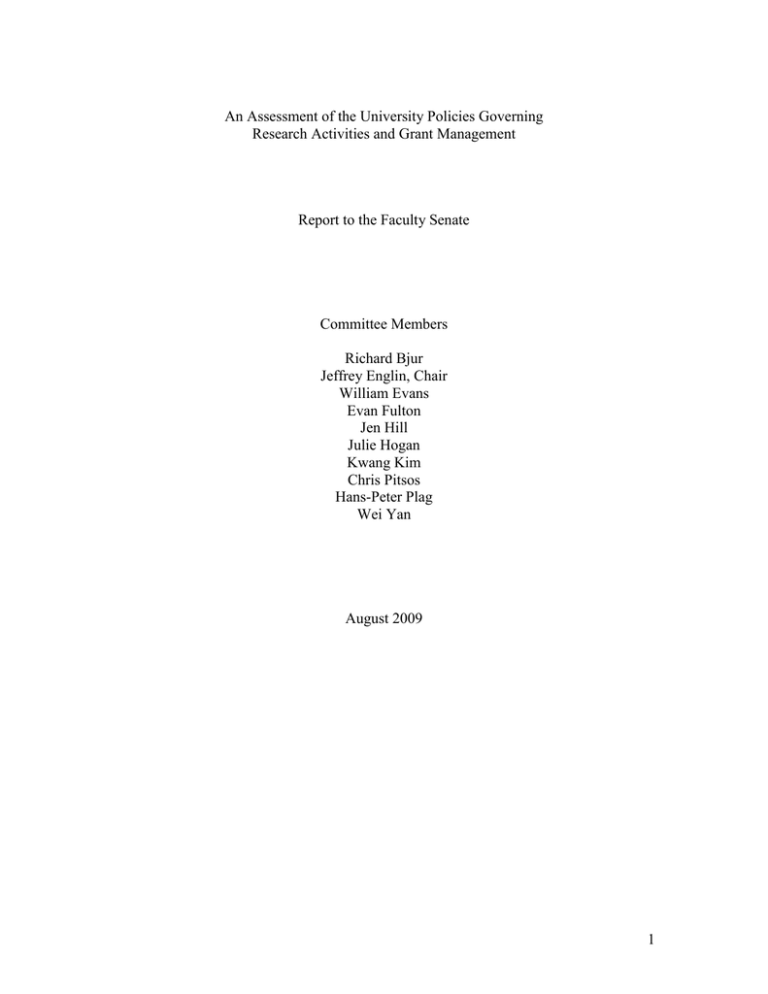
An Assessment of the University Policies Governing Research Activities and Grant Management Report to the Faculty Senate Committee Members Richard Bjur Jeffrey Englin, Chair William Evans Evan Fulton Jen Hill Julie Hogan Kwang Kim Chris Pitsos Hans-Peter Plag Wei Yan August 2009 1 Executive Summary The Ad hoc committee on the assessment of research on the campus at the University of Nevada, Reno has conducted an analysis of policies and procedures that the committee feels constrain faculty success in research. The committee held five meetings in addition to gathering information between meetings. On many issues the committee quickly came to a consensus. It was surprising how often the same issues were encountered by faculty throughout the university. This committee did not attempt to survey the faculty in a systematic manner; this has been done by other committees. Instead, the committee made an effort to synthesize and analyze the findings of other committees and attempted to develop consistent strategies to mitigate problems. The focus was on examining the effects of policies and common practice as much as possible. Implementation of some recommendations does require resources but in general the focus was on changes that could be implemented in this biennium with little if any additional cost. Each section in the document contains a list of specific suggestions that the committee believes could enhance research on campus. Several themes run throughout these recommendations. These include the following: Inadequate flexibility and control at the department level o Space o Teaching Assignments Changing policies to move risk from success off of individual faculty members Opportunity and real costs of inconsistency across colleges and departments Reinventing an institutional culture that views grants as problematic Increasing the professionalism and responsiveness of support staff The committee hopes that this report is of use to the Faculty Senate in the coming months and years. 2 Contents Executive Summary 2 I. Research Environment on Campus Reward System Communication Across Disciplines Inconsistency and its Consequences Space Comparable Institutions 4 4 5 5 5 6 II. IRB Report 6 III. OSPA 8 IV. Non-traditional, non-tenure track faculty 10 V. Faculty Research in the Humanities 11 VI. Review of Extension Report 12 VII. Recommendations regarding a standing committee 13 Appendix A: Full discussion of the IRB Appendix B: Full discussion of the OSPA Appendix C: Full discussion of the Non-traditional, non-tenure track faculty Appendix D: Full discussion of Faculty Research and Creative Activities in the Humanities & Arts Appendix E: Faculty Senate Charges to the Committee 3 I. Research Environment on Campus The research environment on campus is driven by a number of factors. Some of these are institutional decisions about the treatment of research that can be changed directly, some are cultural factors that will only change through time and finally many are external to the university and cannot be easily affected from within. The committee has taken the approach that the existing level of resources cannot be easily increased and so it has concentrated on those changes that are institutional and to a lesser degree cultural. A number of fundamental administrative/institutional decisions fundamentally affect the productivity of faculty. These include the reward system at all levels of the university communication across disciplines inconsistency and its consequences Each of these has a large impact on the research atmosphere and is largely with the control of central administration. Reward System The effect of the reward system at UNR on research activities became clear at the first committee meeting. Throughout campus the rewards to teamwork within UNR was dramatically less than the rewards to teamwork outside of UNR. The reward to being the institutional PI was far greater than being an institutional Co-PI, especially one on a larger team. This shows up institutionally in the lack of large multi-disciplinary programs such as the NSF IGERT program. One can develop lists of multi-disciplinary programs where UNR does not compete. The treatment of Co-PI’s in the merit and reward system has a direct effect on the willingness of faculty to assume a subordinate role on a grant. It is difficult to receive much recognition if one is the seventh Co-PI on a grant, even if without that faculty member the grant would not have been funded. Driving more faculty to become PI’s and diminishing the importance of Co-PI’s leads to smaller, less competitive proposals and less funding. A second level of concern with the reward system is at the college and department level. In a system where colleges and departments are evaluated relative to each other the pressure on PI’s is to not reach across collegiate or departmental boundaries to build teams unless absolutely necessary. It is far better to reach across university boundaries to another institution. A strict accounting of each college’s or department’s placement with respect to extramural funding drives wedges between colleges and departments and makes cross-college activities problematic for faculty. One simple administrative choice could be to change the treatment of cross-college or cross-department grant activities. Emphasizing the extra value the university gets from working together rather than competing internally would bring a quick cultural change in the institution. 4 A final observation about the reward system was expressed universally by the committee members. There is a perception that grant getters are perceived as causing “extra work” by and for departments, less successful and non- grant writing colleagues, and administrative support staff. This perception is linked in part to the design of the reward system. Rather than being understood as very important additions to the fiscal and intellectual life of the institution, requests to support grants and grant activities often are viewed as a source of friction within the institution. Communication across disciplines An important issue is the difficulty with communication across disciplines. This is likely the result of or intertwined with the rewards system discussed above. The informal research communication lines between departments and colleges are ineffective on this campus. This is partly due to the paucity of very large research teams that lead to networking within the institution. As a result, it is hard for faculty to locate the necessary expertise on-campus even where it exists. Given that active faculty often have existing relationships outside UNR it seems clear that these networks will not develop unless there is an incentive or encouragement to seek on-campus collaboration. Inconsistency and its consequences While Emerson’s observation that “A foolish consistency is the hobgoblin of little minds, adored by little statesmen and philosophers and divines” it is also true that substantive inconsistency across colleges and departments is a major barrier to collegial cooperation in research. Inconsistent policies create perceived inequities between faculty within the institution and can strain otherwise productive teams. An example is the treatment of salary savings across colleges. Some colleges return all salary savings to the contributing PI while others keep a tax and still others, apparently, keep all of it. Clearly this makes the construction of a budget amongst faculty in these colleges challenging at best. In addition, the pressure on faculty teams to allocate salary savings within different colleges can clearly be intense in difficult financial times. It is not the intention of this committee to suggest that operational differences between colleges and departments are inappropriate. Quite the contrary, flexibility is important. But it should be noted that some inconsistencies are counter-productive and lead to internal friction, and discourage collaboration. It may be worthwhile for the inconsistencies to be examined more closely and central administration to consider some boundaries on some of the inconsistencies, or failing that, some guidance for faculty on how to resolve these inconsistencies in a productive manner. Space The committee has significant reservations about present procedures for allocating space. It is well recognized that space is at a premium and that it must be carefully managed. This has translated into, at least in faculty perception, a reluctance to pursue grants that 5 require additional space, as the prospect of going to central administration for space to perform the work after getting a grant and possibly getting turned down creates a disincentive to pursue funding. While it is clear that major space allocations must be made in central administration, it would change the incentives for faculty if departments had space that was under the control of the department they could confidently allocate. At the department level there is clearer understanding of what is needed to support research than at either the college or university level. It is easier to “work it out” among colleagues at the department level. Obviously, these allocations would evolve through time. It seems clear to the committee that the uncertainty about space is affecting grant seeking activities by faculty; mitigating the individual risk that faculty feel would remove one more barrier to increased grant activities. Comparable Institutions Just as Central Administration has focused on defining comparable institutions, the committee believes that departments and interdisciplinary programs should do this as well. There is considerable heterogeneity on campus, but compelling each unit to define its own peer and aspirant departments at other institutions will be helpful. First, it will greatly enhance the quality of the metrics used by UNR units to measure success. Specificity of goals and desired outcomes will naturally follow from identification of other departments in other institutions that we want to emulate. Second, these institutions can provide models of organization and behavior that has lead to greater success at peer, yet higher-achieving institutions and their programs. Encouraging each unit at UNR to have an internal dialogue on the topic of comparable departments in other institutions and then pushing forward to adapt the metrics that reflect those departments successes will enhance departmental activities in research by providing a road map for UNR departments to follow as well as a way to measure success or failure. II. Review of IRB Report As part of the charge to this ad-hoc committee, we have reviewed the recommendations of the 2007-08 Provost’s Ad-Hoc IRB committee, as well as two other recent reports related to the UNR IRB activities. These included two internal reports, one from the Center for Research Design and Analysis from 2007 (discussing a faculty survey of perceptions regarding the UNR VPR research support services) and another from a Faculty Senate Ad-Hoc committee that reviewed Human Subject Protection Process at UNR, released in June of 2008. This committee endorses most of the recommendations of the Provost’s Ad-Hoc IRB committee, which also endorsed many of the recommendations found in the Faculty Senate’s Ad-Hoc committee report. The OHRP office is a service and regulatory unit within UNR that has an opportunity to create a culture of compliance, protection, and expectations for excellent research 6 protocols involving human subjects. With the implementation of the above recommendations, we believe this culture is attainable in the near future. The Provost’s Ad-Hoc OHRP committee also recommended that no further overall studies of OHRP need be performed until after improvements are made in infrastructure support and operations to improve OHRP performance and improve faculty understanding of the roles and responsibilities of this office. We also support this recommendation and note that substantial progress on many of the recommendations outlined above has already been made. This includes the soon to be implementation of IRBManager and a revamped website. The Faculty Senate IRB Report and the Provost’s Ad-Hoc OHRP committee recommend the creation of a Review Group to assist the OHRP in streamlining its operations and educating faculty. If an advisory committee or council is used to aid in process improvement and communication with faculty, we believe the existing Executive Board of the IRBs could be used, as the Provost’s OHRP committee has recommended. These recommendations, which we have paraphrased from the above mentioned reports, include: 1. Perform an internal assessment to estimate the degree to which resources (equipment, office and file space, technological support, personnel) and/or systems and procedures currently limit efficient operation of the OHRP. 2. Update the OHRP website (additional institutional support will be required). 3. Establish, measure and publish performance metrics for OHRP. 4. Clarify the roles of the OHRP Director and staff, including the central roles and authorities of the VPR office and Director of OHRP to establish and monitor institutional policies regarding human research 5. Adopt targeted measures to increase understanding of OHRP functions by researchers and potential or newly appointed IRB panel members. 6. To encourage participation in research review, provide tangible rewards for IRB service coupled to performance and proportional to responsibility, and align review panel composition with protocol volume 7. Critically evaluate the benefits and costs of AAHRRP accreditation, with full consideration for the important role of the Veterans Administration affiliates in collaborative research and education. 8. To speed protocol review, consider an alternative, distributed mechanism (e.g. delegated to departments or schools) for evaluating scientific merit. 9. Explore the possibility of extending UNR IRB approval for human research at major affiliates. 7 10. Explore the implications of “Unchecking the box”. This restricts federal audits to human research protocols that are federally funded, and allows the development of an alternate review process for non-federally funded protocols. 11. Engage Nevada’s congressional delegation in the national dialogue regarding the scope of human research protection activities for social and behavioral research. III. OSPA OSPA and UNR Administration are encouraged to be a change agent in shifting the research culture from one that reflects a “campus of the 1970’s…that is in crisis mode regarding its research” (Pappas Report, April 2008) to one that creates and sustains cross departmental research work. This can be done, in part, by highlighting PIs and their teams who have successfully obtained extramural funding, marketing and celebrating grant accomplishments, actively identifying and supporting interdepartmental research teams, and submitting and receiving grant/contract funding. This will likely help the university to reach goals reflective of a modern twenty-first century research institution and not mirror an institution of the 1970’s. It is recommended that OSPA and the UNR Administration facilitate and transition the campus to a research institution of excellence through a carefully executed communication and strategic plan. OSPA is implementing a new e-mail notification process where the PI, Chair, and dean are sent a congratulatory email which also contains pertinent grant/contract information. This e-mail can also be forwarded to the UNR Office of Communications for press release generation which will inform the larger campus community and city of Reno media. OSPA should be commended for this new procedure and be encouraged to continue this as part of a fully developed communication and strategic plan. Recommendations (dependent upon fund availability) 1. Sponsored research at UNR has more than tripled over the past ten years – from $30.6M in FY98 to $94.6M in FY07. Administrative staffing levels, both within OSPA and the various departments, have not kept pace with the increased workload. In addition, the laws, rules, regulations and guidelines governing the processes – from submission through closeout – have become increasingly complex. As a result, faculty are absorbing the additional work necessary to seek, obtain and manage sponsored projects. 2. To reduce the additional administrative burden placed on PIs, we recommend that OSPA perform a desk audit to evaluate staffing levels and hire the necessary staff to provide adequate and timely customer service and to provide more support to faculty in meeting the burdensome administrative requirements of seeking funding opportunities, generating budgets and managing awards 8 3. The committee recommends that OSPA continue to adopt a ‘management by objectives’ approach, adjusting its procedures in order to meet its objectives, using the performance measures specified above as a guide and adopting new performance measures as needed. 4. While reviewing the policies and procedures of OSPA, the roles of OSPA staff should be better communicated to faculty and their staff. 5. OSPA should continue to review all policies and procedures, update same and provide training to staff to ensure consistency and accuracy in information provided by all staff to the best of their ability. As part of this training, staff will be better advised on how to prioritize their work. 6. Additional steps should be taken to eliminate needless workload on the office. For example, fee for service contracts, which are not public service sponsored projects, are no longer processed by OSPA, but routed to the appropriate office and signature authority. 7. Both the executive director and OSPA staff should continue to strive to improve communication with faculty and their staff. This will include more clearly outlining the roles of OSPA, deans/chairs and PIs. The following should be broadcast to faculty and their staff via e-mails, training and department meetings: - Any changes to OSPA policy - Any changes to sponsor guidelines and/or regulations, as well as any clarifications thereof In addition, OSPA staff should keep faculty and their staff informed: - Via e-mail throughout any contract negotiations o PIs should be consulted prior to modification of any contract/grant terms and conditions, particularly those that affect budget. - Automatic e-mails should be generated to PIs and their deans/chairs upon receipt of an award - PIs only should be notified promptly of any proposal rejections In the spirit of this report, the actual impact of these improved forms of communication should be on a bottom-line focus. For example, if e-mails to faculty and staff do not have the desired impact in knowledge and compliance, further changes in communication procedures and methods should be sought. 8. OSPA should fill any vacancies in a manner that provides the most effective mix of professional and classified staff. In addition, OSPA management should provide additional training, and ongoing training, in: - Customer service - Changes in laws, rules, regulations pertaining to proposals and awards 9. The general attitude of OSPA staff should continue to shift from gatekeepers and/or compliance officers to facilitators. While it is important to ensure the academic integrity of the institution and its faculty, better communication could rectify this by explaining the 9 legal implications of certain activity and working with faculty to find appropriate solutions. It is important that OSPA staff form team partnerships with PIs and their staff. 10. Following through on the request for bids for a web-based system to allow for paperless approvals, electronic signatures, and grant/award tracking and administration is highly recommended. The system should be capable of auto-generating friendly reminders to faculty and their staff concerning the status of their awards (reports due, closeout is imminent, etc.). This will not only free up faculty time from walking requisite forms through the approval system, it will free up time of OSPA staff – time better spent in providing additional customer service. Moreover, this will reduce the number of documents not found by OSPA (or reduce the time required to locate same). Lastly, such a system would allow OSPA to generate customized reports for PIs as well as administration. 11. OSPA should work with a faculty group (including deans, chairs and the proposed standing Faculty Senate Committee on Research and Grants) to streamline the internal processes, both the approval process as well as finding a way to reduce the lead time required by OSPA to review and submit proposals. 12. To avoid the bottleneck and ensuing delays, OSPA should continue to cultivate backups for staff so that a single person does not become a bottleneck. 13. Create a mentoring program where new faculty are mentored by OSPA staff and experienced PIs to help “grow” new investigators. 14. It is advisable that policies and procedures be examined to fully ensure UNR compliance with the laws, rules and regulations governing sponsored projects. 15. OSPA should work with the university departments to create budgetary assistance to PIs so that fiscal proposals can be created at the department level with staff that has expertise in this area. 16. With regard to effort reporting, faculty report feeling constrained by the Federal policy that caps effort to bring in new funding at 5%. It is hoped that this limit be raised to 10% from additional funding. IV. Recommendations on NTT Faculty 1. It is recommended that a system of bridge funding for NTT faculty be developed to cover brief periods without funding, due to shortfall/end of funding or emergency situations such as illness or pregnancy. 2. It is recommended that faculty on B contract be offered the option of having retirement benefits paid on overload salary. 10 3. It is recommended that a funding mechanism for a competitive professional development leave be explored. Professional leave may possibly be funded through revised fringe benefit rates 4. It is recommended that the minimum number of days of notice for a notice of nonrenewal is increased to be at least 60 days, with number of days of notice possibly being linked to longevity. 5. It is recommended that the possibility of using state funds to temporarily support nontraditional faculty to increase the kinds of roles that these faculty can play on campus. There are currently between 550 and 600 tenured or tenure track faculty and about 250 NTT faculty members. Use of state funds to help support these faculty members would allow them to play a bigger role in the teaching and service mission of the university. 6. It is recommended that the university revisit the policies on the position classification of NTT. In particular it seems capricious to lock a staff member into the job description where they were originally hired if, over time, their responsibilities change. 7. It is recommended that the possibility of partial tenure track lines be explored. Half state funded and half soft funded positions provide greatly enhance job security, allow a broad range of activities by the faculty member and while retaining the incentive to generate grants. V. Recommendations on Faculty Research and Creative Activities in the Humanities & Arts 1. Promote continued understanding of models of humanities research at higher administration levels in order to accommodate time intensive nature of much humanities scholarship and creative activity. 2. Continue to develop better tracking of grant, fellowship, and residency opportunities by the research offices. (This has improved in recent years, but could continue to improve.) 3. Acknowledge that research fellowships or residencies occur off-site and require teaching and service load accommodation by departments. 4. Reduce academic isolation in fields with low representation in UNR curriculum and programs. UNR’s isolation from powerful networks of scholars and resources is perceived as limiting competitiveness for research funding and opportunities. 5. Continue to reserve CLA scholarly and creative activities funds for competitive distribution to scholars across the college and disciplines for support and subvention of research and performance. 11 6. Help develop a model of the distribution of salary savings to ensure college, and departments are fully committed to pursuit and support of off-site research fellowships, creative residencies, and research travel. 7. Ensure evaluation and compensation models that enable faculty to pursue fellowship and residency opportunities. 8. Fund, seed, or match networking opportunities at nearby (west coast) centers, reading groups, or work groups for productive faculty in smaller departments or who focus on under-staffed areas in large departments. 9. Encourage Knowledge Center to actively solicit faculty input on electronic and paper resources. Provide faculty members with library rights and archive access at nearby research libraries as needed. 10. Accommodate and encourage flexible teaching schedules to enable time-intensive on site or off-site focused research. Enable faculty to apply for and plan for short-term fellowships during future academic years by “stacking” the teaching commitment in one term if desired. 11. Seek and form private/public partnerships and cooperation with local/state agencies and foundations (e.g. Nevada Humanities) at higher administration level, so faculty spend less time working on those relationships and competing with one another for limited resources. 12. Use data on faculty research interests to research funding opportunities in order to notify faculty of possible grant opportunities. VI. Review of the Extension Report One of the charges the committee received was to review the Extension portion of the recent Extension/ Extended Studies report. The specific charge was: Review the relevant portions of the 2007 Report of the Cooperative Extension Review Committee. Review issues in this report that affect the university’s generation of research and grants, make recommendations. The committee has made a number of recommendations that are linked to all colleges and programs on campus. In particular, the fact that Cooperative Extension links with so many other programs in a unique way exacerbates any institutional barriers between colleges and programs. As a result the committee suggests that each of the appropriate suggestions in the rest of the report be applied equally to Cooperative Extension. In addition, there are two Cooperative Extension specific suggestions. These include: 12 1. Cooperative Extension plays a unique role in the land grant system. As such it can provide a competitive advantage to the faculty at UNR with some grants and contracts as well as research and programmatic opportunities through linkages to communities throughout Nevada. The committee urges Cooperative Extension to continue to develop strategies that help unfamiliar faculty learn to leverage Cooperative Extensions unique capabilities. 2. The committee suggests carefully examining how Cooperative Extension can capitalize on its internal integrative role on campus and external outreach networks to enhance research and grant opportunities across disciplines. Cooperation between colleges is essential to further these prospects. Administrative and structural incentives should be pursued to further this goal. V1I. Recommendations regarding a standing committee Charge #4 of the Ad-hoc Committee on Research and Grants was to ”Make recommendations regarding the need, organization and charges of a possible standing committee on research and grants.” Based upon the discussions specific to this charge and discussions/issues which emerged during the course of our meetings, the Ad-hoc Committee on Research and Grants would like to make the following recommendations. 1. Establish a faculty senate standing committee on “Research and Grants.” It was abundantly clear from the very beginning of these meetings that there are a great many issues regarding research and grants which have a significant impact on faculty, staff and student productivity and success. Some of these issues are specific to certain disciplines while others cut across all disciplines. Under any circumstance, but particularly during this time of budget constraints and cutbacks, it will be important for UNR to have a faculty committee to voice the viewpoints and concerns of the research community on campus. 2. The Research and Grants committee should consist of faculty representative of the many colleges, disciplines and types of appointments on campus. Research as well as research efforts take many forms across campus and provide varied challenges to those engaged in these activities. It is important that faculty representative of all disciplines be represented on the committee in order to bring their issues to the table. It is equally important for faculty with different types of appointments be represented on the committee. Research, soft-funded and academic faculty all face different issues in trying to conduct research on campus and their needs should be represented as well. The committee felt that only one research committee should be formed as opposed to creating one for the sciences and another for the humanities as it is important these groups to understand and appreciate the challenges facing each. A committee of 10-12 faculty members with a faculty senate representative would be appropriate. 3. The Research and Grants committee identified numerous areas of concern regarding the research environment on campus. The creation of a standing committee 13 could help begin the process of addressing some of these issues. Some key charges for the committee to consider would include the following: Develop a survey for university faculty to identify key issues for conducting research at UNR. Review the university infrastructure for supporting research and provide alternatives for improvement of current support (i.e. bridge funding, establishment of core facilities, incentives for collaborations among faculty, etc). Review the mechanics for grant submissions at UNR in order to make the submission process more efficient. Review OSPA and Grant and Contracts policies and procedures which may delay or even prevent grant applications from being submitted. Review mechanisms to encourage Research or Soft-Funded Faculty to conduct research at UNR. Develop mechanisms to allow these faculty members to participate in some limited teaching as well as other faculty functions (committee assignments etc). Develop a plan to provide support for faculty in the humanities to conduct research or scholarly work where grants are more difficult to come by and which often involve being away from the campus. 14
